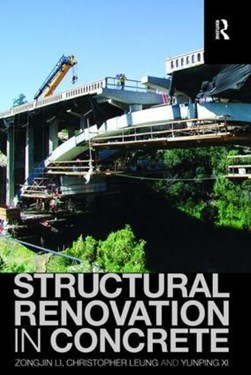-
BROWSE 1000s OF BOOKS IN STOCK
-
FREE DELIVERY ON ORDERS OVER €10
Structural Renovation in Concrete
PAPERBACK
The mechanisms by which buildings and infrastructures degrade are complex, as are the procedures and methods for inspection and for rehabilitation.This book examines the various problems caused by non-uniform deformation changes, poor durability, and natural and human disasters such as earthquakes and fire. Attention is given to the causes and mechanisms of the deterioration. General procedures and commonly used techniques for inspection and evaluation of existing infrastructures are introduced. The desk study, destructive test, and non-destructive test are discussed - in particular the newly developed non-destructive methods for deterioration monitoring. The book then moves on to conventional renovation techniques such as patch and steel plate strengthening, which meet the requirements of normal practice. Special attention is paid to compatibility between repair materials and degraded materials. Fibrous composite materials are then introduced as a basis for innovative repair techniques, and different fibre and matrix properties are outlined, as are newly developed inorganic binders as a matrix for fibrous composites. Finally, advanced rehabilitation techniques using fibrous composite are described. Fundamental issues such as bonding and failure mechanisms are then discussed in detail. Fibrous composite strengthening techniques for beam, wall, column and slabs are covered, including shear strengthening, flexural strengthening, and fillet winding, as are codes of practice for retrofitting with fibrous composites.This caters to students and academics world-wide and serves as a "tool book" for concrete and structural engineering professionals.
€101.49

304 Reward Points
In stock online
Extended Range: Delivery in 2-3 working days
Extended Range: Delivery in 2-3 working days
Free Delivery on this item
Any purchases for more than €10 are eligible for free delivery anywhere in the UK or Ireland!
The mechanisms by which buildings and infrastructures degrade are complex, as are the procedures and methods for inspection and for rehabilitation.This book examines the various problems caused by non-uniform deformation changes, poor durability, and natural and human disasters such as earthquakes and fire. Attention is given to the causes and mechanisms of the deterioration. General procedures and commonly used techniques for inspection and evaluation of existing infrastructures are introduced. The desk study, destructive test, and non-destructive test are discussed - in particular the newly developed non-destructive methods for deterioration monitoring. The book then moves on to conventional renovation techniques such as patch and steel plate strengthening, which meet the requirements of normal practice. Special attention is paid to compatibility between repair materials and degraded materials. Fibrous composite materials are then introduced as a basis for innovative repair techniques, and different fibre and matrix properties are outlined, as are newly developed inorganic binders as a matrix for fibrous composites. Finally, advanced rehabilitation techniques using fibrous composite are described. Fundamental issues such as bonding and failure mechanisms are then discussed in detail. Fibrous composite strengthening techniques for beam, wall, column and slabs are covered, including shear strengthening, flexural strengthening, and fillet winding, as are codes of practice for retrofitting with fibrous composites.This caters to students and academics world-wide and serves as a "tool book" for concrete and structural engineering professionals.

304 Reward Points
Any purchases for more than €10 are eligible for free delivery anywhere in the UK or Ireland!
€101.49

304 Reward Points
Any purchases for more than €10 are eligible for free delivery anywhere in the UK or Ireland!
Product Description
The mechanisms by which buildings and infrastructures degrade are complex, as are the procedures and methods for inspection and for rehabilitation.This book examines the various problems caused by non-uniform deformation changes, poor durability, and natural and human disasters such as earthquakes and fire. Attention is given to the causes and mechanisms of the deterioration. General procedures and commonly used techniques for inspection and evaluation of existing infrastructures are introduced. The desk study, destructive test, and non-destructive test are discussed - in particular the newly developed non-destructive methods for deterioration monitoring. The book then moves on to conventional renovation techniques such as patch and steel plate strengthening, which meet the requirements of normal practice. Special attention is paid to compatibility between repair materials and degraded materials. Fibrous composite materials are then introduced as a basis for innovative repair techniques, and different fibre and matrix properties are outlined, as are newly developed inorganic binders as a matrix for fibrous composites. Finally, advanced rehabilitation techniques using fibrous composite are described. Fundamental issues such as bonding and failure mechanisms are then discussed in detail. Fibrous composite strengthening techniques for beam, wall, column and slabs are covered, including shear strengthening, flexural strengthening, and fillet winding, as are codes of practice for retrofitting with fibrous composites.This caters to students and academics world-wide and serves as a "tool book" for concrete and structural engineering professionals.
Product Details
ISBN9781138115071
FormatPAPERBACK
PublisherCRC PRESS (31 May. 2017)
No. of Pages354
Weight453
Language English
Dimensions 234 x 231 x 28

